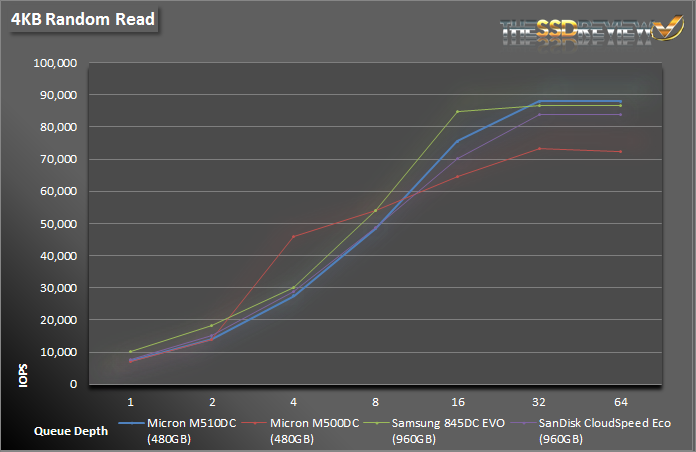MEASURING PERFORMANCE
As with all of our tests, the following tests were performed after a secure erase of the drive. The drive is then conditioned with a predefined write workload until it reached steady state. We also test across the entire span of the drive.
 In terms of pure read IOPS, the M510DC is very competitive, results are even better than the M500DC’s from our review last year. The Samsung 845DC EVO and CloudSpeed Eco put up a good fight with slightly better results in the lower QDs, however, the M510DC peaks out just slightly once it reaches QD32.
In terms of pure read IOPS, the M510DC is very competitive, results are even better than the M500DC’s from our review last year. The Samsung 845DC EVO and CloudSpeed Eco put up a good fight with slightly better results in the lower QDs, however, the M510DC peaks out just slightly once it reaches QD32.
In terms of writes, the M510DC is a clear winner when compared to the two other read oriented SSDs. Write IOPS are nearly double that of the SanDisk and Samsung SSDs. Looking at the results overall, it also shows very consistent performance fluctuating just around 1,000 IOPS from QD1 on. Once compared to its older brother, the M500DC however, you can see that it can’t compete. The M500DC is much better suited for random write workload performance than the M510DC.
During our 128K sequential test we can see that the M510DC maxes out in read performance at QD4 reaching 443MB/s. However, the Samsung 845 EVO easily tops its performance with read speeds of over 500MB/s. When looking at write performance on the other hand, the M510DC has taken the lead once again, reaching 413MB/s. Surprisingly, our results from the M500DC don’t fair too well given its higher product specifications ranking.
SNIA IOPS TESTING
The Storage Networking Industry Association has an entire industry accepted performance test specification for solid state storage devices. Some of the tests are complicated to perform, but they allow us to look at some important performance metrics in a standard, objective way.
SNIA’s Performance Test Specification (PTS) includes IOPS testing, but it is much more comprehensive than just running 4KB writes with Iometer. SNIA testing is more like a marathon than a sprint. In total, there are 25 rounds of tests, each lasting 56 minutes. Each round consists of 8 different block sizes (512 bytes through 1MB) and 7 different access patterns (100% reads to 100% writes). After 25 rounds are finished (just a bit longer than 23 hours), we record the average performance of 4 rounds after we enter steady state.
- Purge: Secure Erase, Format Unit, or vender specific
- Preconditioning: 2x capacity fill with 128K sequential writes
- Each round is composed of .5K, 4K, 8K, 16K, 32K, 64K, 128K, and 1MB accesses
- Each access size is run at 100%, 95%, 65%, 50%, 35%, 5%, and 0% Read/Write Mixes, each for one minute.
- The test is composed of 25 rounds (one round takes 56 minutes, 25 rounds = 1,400 minutes)
Unlike our other performance tests, the SNIA tests only last for a relatively short period of time each (1 minute), but they cover many more access patterns and transfer sizes. You may have noticed that some of the SNIA results are higher or lower than in our other tests. The reason for this is because SSD performance is heavily predicated on previous workloads. Toggling between large and small blocks and reads to writes is stressful on the drive and results can vary. This is why we take the average of multiple runs. What it does show is how well a drive’s firmware can perform garbage collection, TRIM and many other internal housekeeping tasks.
The SNIA results quickly show us how well the M510DC performs compared to its specs. While it is rated for up to 63,000 4K read IOPS, here we see it reaching nearly 75K IOPS during 100% read! Again, at 100% write we see it achieving 29K IOPS, over 6K IOPS more than it is rated for. Unlike most read centric SSDs, whose write performance tends to continually fall, we can see a slight bathtub curve from the read/write mixes for the M510DC thanks to its extra OP and M500DC DNA (design and firmware).
 The SSD Review The Worlds Dedicated SSD Education and Review Resource |
The SSD Review The Worlds Dedicated SSD Education and Review Resource | 
